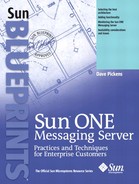Number of Messages
In many ways, email has taken over what the telephone used to do. Today it is not uncommon for someone who is an active email user to receive over 100 messages per day or more. Try to think of the last time you had 100 voice mail messages waiting in your voice mail box. Some say that instant messaging (IM) is going to overtake email and email will be obsolete. There is no doubt that instant messaging will affect email in some manner, but IM is a real-time communication method akin to actually talking on the phone. Email is like calling someone who is not there or is busy, and leaving a message on their answering machine or voice mail. Email is asynchronous and does not require the user's immediate attention like instant messaging does, although many people leave email running all the time and use it like IM in some ways.
Another issue with IM is interoperability. IM is an immature technology when compared with email. It is hard to bridge across Yahoo! and AOL or MSN using IM, for example. The situation is getting better with the advent of new protocols such as Simple Internet Protocol (SIP) and SIMPLE, but IM is not there yet—and it is not quite as universal as email.
Another issue driving up the quantity of messages being sent and received is that other systems are becoming more integrated with email. Today many organizations are looking for unified messaging, providing a single point for email, faxes, and voice mail. Unified messaging allows integration between an organization's voice mail system (or fax system) and an email (messaging) system in such a way that the voice mail system actually stores the voice mail messages in a person's email inbox (or other folder). That way you can read your email and listen to your voice mail (or see your faxes) without having to check two separate systems. This capability adds yet another factor in terms of volume as well as size, since audio attachments can be large depending upon the sampling rate.
At some point in the future, IM might actually participate in this unified messaging environment. Imagine that email becomes the answering machine or recording device for IM sessions—for example, you are not able to participate in the 11:00 a.m. IM session to discuss the new marketing campaign, but the conference (including all the attachments and collaboration) gets saved in your inbox. How exactly has IM reduced your messaging requirements? IM might, in fact, add more traffic to your messaging system.
